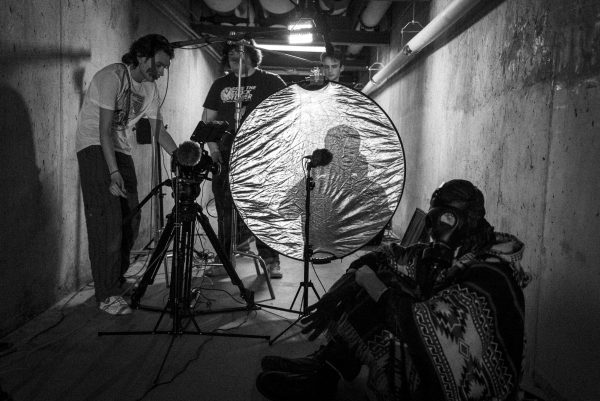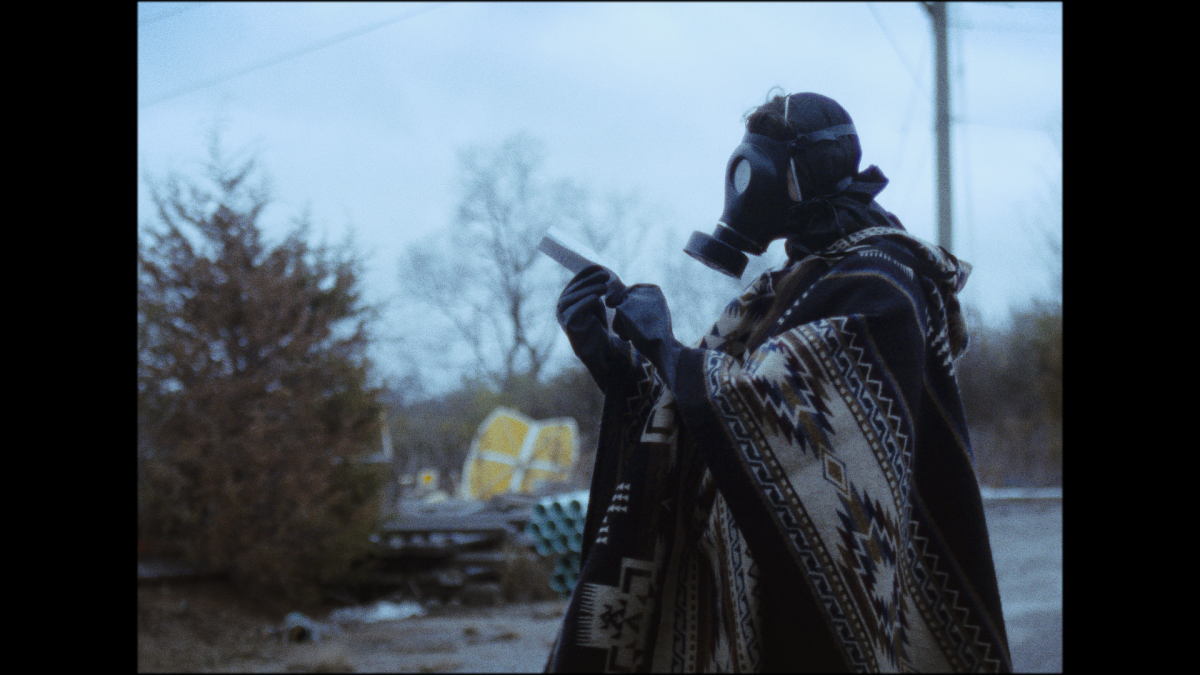An ominous figure slowly walks through a desolate landscape. A gas mask obscures his features; its fogged lenses mirror the bleak sky above. He glances at the overturned, abandoned furniture and takes in rusted metal scraps reflecting the dull shine of a weak winter sun. Menacing graffiti faces leer from crumbling concrete walls. Debris litters the ground as his black boots crunch along the rocky path.
Pausing, the wiry man gazes at the wispy clouds as sleet pelts his head. His patterned poncho billows in the breeze while his gloved hands fumble with a small paper airplane, deftly folded and dotted with words. With a hopeful flick of the wrist, he throws it. The airplane takes a small, pitiful leap before nose-diving toward the ground. Shoulders slumped, he stares at it in dejection—the wind whistles in his ears, punctuated by the foreboding caws of crows.
“Cut!”
Camilo Idrobo removes his gas mask, shaking out strands of long, dark hair matted with sweat, drawing in deep breaths of cold air. He welcomes the refreshing sting to his lungs; wearing the prop for so long on set is stifling. Idrobo is starring in his own short film, written and directed by himself, inspired by his life.
“I like to have control over the image,” Idrobo said. “That’s not always possible, especially if you’re on the other side of the camera. Luckily, I have a good crew I can trust.”
It’s a dreary day to film. A few lonely snowflakes drift down from the sky, landing on chapped lips and red noses. Brief spells of sleet follow with groans as Idrobo’s crew quickly cover their expensive equipment. Bundled up, their breaths appear like puffs of smoke in the frigid air, mingling together as they huddle around scattered tripods, microphones, lenses and notes.
Idrobo assembled this crew to help bring his film, titled “Cross the Valley,” to life. As part of the Electronic Media Broadcasting program, students are often required to make short films for final projects, but creating them is an extensive process. While the finished product may only be minutes long, it is the culmination of arduous days of planning, filming and editing

“When I get one idea in my head that I want to do, you can’t get it out of me,” Idrobo said. “Even if it’s not possible or it’s frustrating, I will still give it a try.”
Idrobo tends to create abstract works that mirror his life. His character roams a post-apocalyptic world plagued by radiation, hence the gas mask. To protect his body, he dons an authentic Ecuadorian poncho from the Imbabura province, a cherished relic from his homeland.
An international student from Ecuador, Idrobo struggles to stay in contact with his family and friends back home. The country is facing a severe drought that has led to widespread power outages, leaving his family with only four hours of electricity each day. At times, he goes weeks without being able to reach them. This frustration is mirrored in the film’s protagonist, who writes a letter to his parents, folds it into a paper airplane and releases it in a futile attempt to bridge the distance that separates them.
“It comes from my own inability to communicate with my family,” Idrobo said. “I don’t say all these things in the film. It’s very metaphorical. But it always comes from that certain real place in my heart.”
Like any EMB project, “Cross the Valley” has been met with challenges. One aspect of filming is location scouting. Once a location has been secured, problems can arise the day of. Crew or cast cancel, batteries are forgotten or the set is just too noisy. For Idrobo, it was the weather.
He filmed in a random, clandestine lot at Northern Kentucky University where things no longer wanted are dumped: old furniture, abandoned traffic cones and rusty tools. But the day was rainy and relentlessly cold—not ideal for shooting outside. Forced to improvise, he found an alternative spot that offered shelter to his crew, which was better than his initial idea.
“You gotta be flexible. I like the accidents and the spontaneous things that happen. That’s where I have the most fun,” Idrobo said. “If it wasn’t stressful, if it’s not difficult, it’s not why I do it anymore.

On Idrobo’s set, there’s a camera operator, an audio technician and two co-producers; one of whom is Matti Davis. She walks around with a large binder, scribbling down thoughts with a gloved hand. Her blue-green eyes squint in the pale light, periodically pulling out a camera to capture photos. As a producer, Davis manages the budget, procures props and takes comprehensive notes during filming.
Since Idrobo is the sole actor in the film, Davis also acts as a “second pair of eyes” to guide his actions to fit his vision. Like Idrobo, Davis thrives on the chaos of the process. She embraces the sleepless nights and inevitable mishaps, knowing that the end result would not be nearly as fulfilling without them.
“It is so stressful, and I go to bed at night and I struggle to breathe a bit. I have nightmares that I forgot to get a prop and we start filming next week,” Davis said. “But it’s so rewarding. Once the production is in play, all of that hard work, I see it unfolding before my very eyes. It’s so beautiful.”
While Idrobo and crew bear the sleet and freezing temperatures to capture his post-apocalyptic story, fellow EMB student Yousef Naji’s project unravels in the historic streets of Newport, Kentucky, with all its red-brick exteriors and bustling nightlife. Though their settings couldn’t be more different, both filmmakers must navigate the hurdles that often reshape their original visions, all with the help of a reliable crew.
Naji’s documentary, “Newport Sin City: The Murder of Melvin Clark,” explores the true thrilling story of two rival mobsters from Newport, known as the original Sin City. Their animosity culminates in a fatal duel, leaving one shot dead. The other dies decades later, mysteriously falling out of a hospital window after his nurses are dismissed by a pair of nameless visitors in dark suits.
Unspooling like an old film reel, all this and more unfurls in just seven minutes, narrated by Naji himself.
“It’s short, it’s sweet, but there’s a story; there’s a middle and end,” Naji said. “You need time to establish your setting, the context of the time period, yourself as a reputable spokesperson, the interviewees and enough b-roll to make it engaging.”
With such a short time frame, Naji had to change his project during the editing phase to accommodate all the details. For his original narration, he filmed himself dressed as an old-fashioned detective, clad in a long trenchcoat and a fedora covering his unruly curls. But he cut these scenes to retain conciseness. Instead, Naji remains off-screen, using NKU’s recording studio to obtain a crisp narration of the overarching story.
Since he can’t show off his detective outfit, Naji emulates the classy aesthetic through noir music and stock footage. Embracing the role of an investigator, he conducts interviews and digs up old newspaper clippings to help reveal real events of the 1950s. While Naji’s process mirrors Idrobo’s in many ways, it leans more heavily on historical research and interviews to build the narrative.
“I love interviewing people, especially when it’s someone that cares what they’re talking about,” Naji said
For things like color grading, Naji collaborates with other students, similar to how Idrobo seeks assistance with audio. By working with peers who excel in specific areas, they can enhance parts of their projects. Both traverse the time constraints and weather-related disruptions that force them to adapt. But for many EMB students, the final product—with all its welcomed and unwelcome surprises—holds greater significance than just a grade for class.
“When I have a story or an idea, I really want to try and stick with it,” Naji said. “It’s an assignment, but you want to do it well; it’s your work.”



